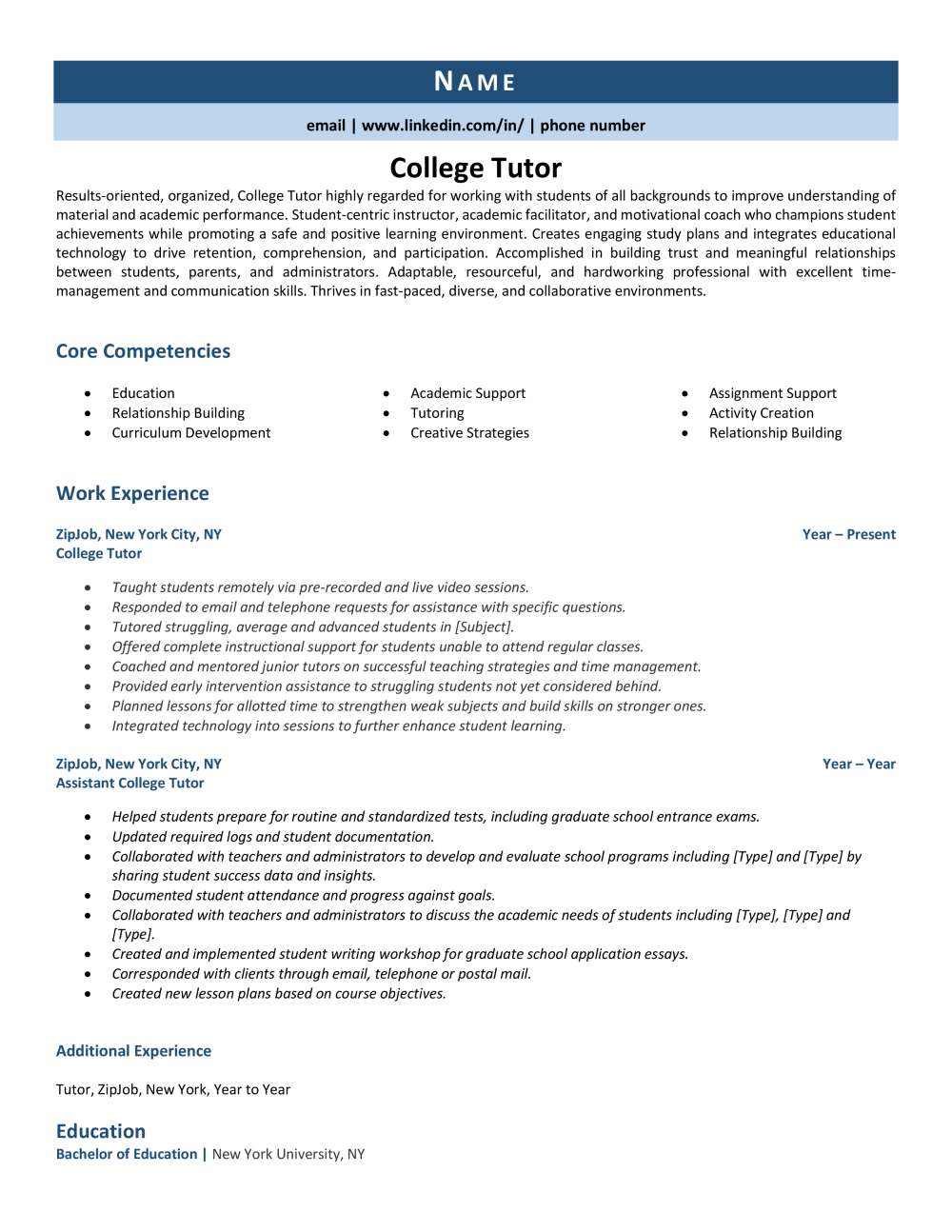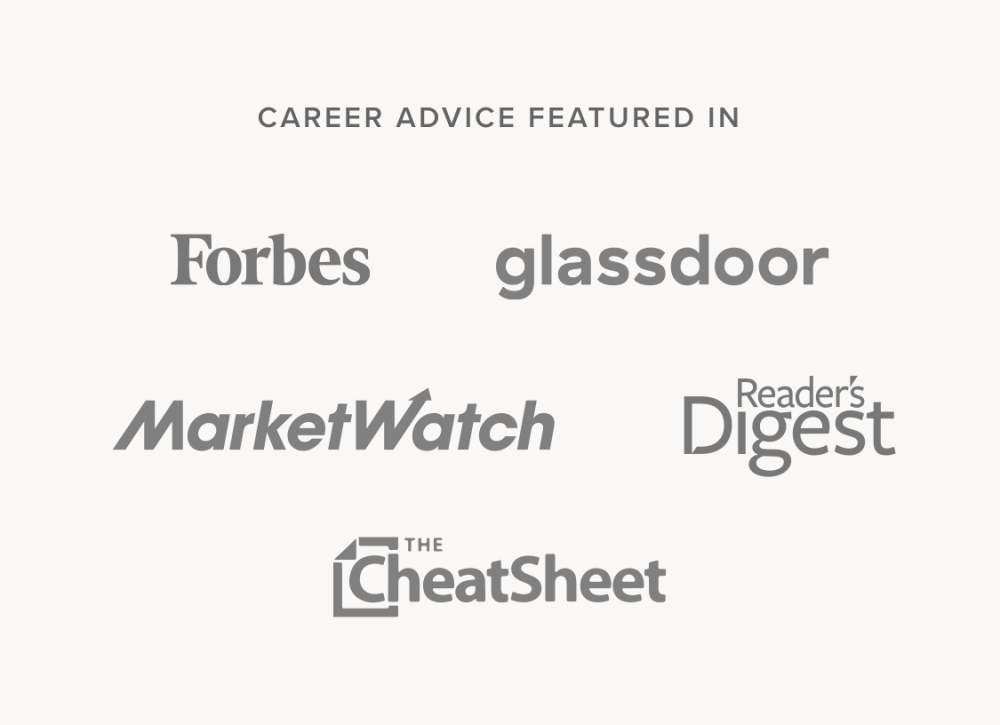College Tutor Sample
Download and customize our resume template to land more interviews. Review our writing tips to learn everything you need to know for putting together the perfect resume.
A College Tutor tutors college students in a chosen subject. Below is a sample job description for a tutor:
A tutor is a wide-ranging teaching position in which an instructor usually works one-on-one or in a small group setting with a pupil, in order to learn an academic subject or a specific skill. The study or training sessions are usually conducted in person, although tutors can also work remotely via video, live chat, or email. A large portion of tutors are academic and work for high schools, colleges, or universities. Tutors are usually very well-versed in the subject they are teaching and are able to effectively convey that knowledge to their students. Good tutors provide a friendly and productive learning environment for their clients.
Expert Tip
You should never use a creative resume
Many job seekers think that an eye-catching resume template will help them stand out to hiring managers and increase their chances of landing an interview. This is a myth put out by resume builders that value design over content.
The truth is that most hiring managers prefer a traditional resume format.
Creative resume templates, like the one pictured here, can actually hurt your chances of landing an interview. Instead, you should use a basic resume format that quickly communicates your basic information and qualifications–like the one included below.
College Tutor resume (text format)
How confident are you feeling about your resume? If you need more help, you can always refer to the following resume sample for a position.
Name
Title
City, State or Country if international
Phone | Email
LinkedIn URL
COLLEGE TUTOR PROFESSIONAL
Results-oriented, organized, College Tutor highly regarded for working with students of all backgrounds to improve understanding of material and academic performance. Student-centric instructor, academic facilitator, and motivational coach who champions student achievements while promoting a safe and positive learning environment. Creates engaging study plans and integrates educational technology to drive retention, comprehension, and participation. Accomplished in building trust and meaningful relationships between students, parents, and administrators. Adaptable, resourceful, and hardworking professional with excellent time-management and communication skills. Thrives in fast-paced, diverse, and collaborative environments.
CORE COMPETENCIES
Education
Relationship Building
Curriculum Development
Academic Support
Tutoring
Creative Strategies
Assignment Support
Activity Creation
Relationship Building
PROFESSIONAL EXPERIENCE
College Tutor
ZipJob, New York NY | Year to Year
Responsibilities
Taught students remotely via pre-recorded and live video sessions.
Responded to email and telephone requests for assistance with specific questions.
Tutored struggling, average and advanced students in [Subject].
Offered complete instructional support for students unable to attend regular classes.
Coached and mentored junior tutors on successful teaching strategies and time management.
Provided early intervention assistance to struggling students not yet considered behind.
Planned lessons for allotted time to strengthen weak subjects and build skills on stronger ones.
Integrated technology into sessions to further enhance student learning.
Assistant College Tutor
ZipJob, New York NY | Year to Year
Responsibilities
Helped students prepare for routine and standardized tests, including graduate school entrance exams.
Updated required logs and student documentation.
Collaborated with teachers and administrators to develop and evaluate school programs including [Type] and [Type] by sharing student success data and insights.
Documented student attendance and progress against goals.
Collaborated with teachers and administrators to discuss the academic needs of students including [Type], [Type] and [Type].
Created and implemented student writing workshop for graduate school application essays.
Corresponded with clients through email, telephone or postal mail.
Created new lesson plans based on course objectives.
EDUCATION
Complete School Name, City, St/Country: List Graduation Years If Within the Last Ten Years
Complete Degree Name (Candidate) – Major (GPA: List if over 3.3)
Relevant Coursework: List coursework taken (even include those you are planning on taking)
Awards/Honors: List any awards, honors or big achievements
Clubs/Activities: List clubs and activities in which you participated
Relevant Projects: List 2-3 projects you have worked on
Everything you need to write your college tutor resume
Now that you’ve seen an example of a job winning College Tutor resume, here are some tips to help you write your own. You should always begin with a summary section. Remember to use basic formatting with clear section headings and a traditional layout. Finally, be sure to include top skills throughout your resume. We’ve included several examples common for College Tutor below.
Let’s start with your resume summary section.
1. Summary
The resume summary replaces the out-of-date resume objective. A summary outlines the most impressive parts of your resume for easy recall by your potential employer, while also serving to fill in personal qualities that may not appear elsewhere on the page. Remember that summaries are short and consist of pithy sentence fragments! You can check out the College Tutor resume example for more information!
Expert Tip
Always start with your most recent positions at the top of your resume. This is called reverse-chronological format, and keeps your most relevant information easy for hiring managers to review.
2. Formatting
Our experts recommend you start your resume with a resume summary, like the one above. Other common sections are Work Experience, Education, and either Skills or Core Competencies. Here are some guides from our blog to help you write these sections:
Some resumes will include other sections, such as Volunteer Experience or Technical Skills. When it comes to what sections you need to include on your resume, you will know best!
Other sections for you to consider including are foreign language skills, awards and honors, certifications, and speaking engagements. These could all be relevant sections for your resume.
3. Appropriate skills
Your resume should include all your skills that are relevant to your target job. Skills include both hard skills and soft skills. Hard skills are the technical know-how you need to complete a job, such as data analysis or HTML. Soft skills are harder to quantify. Some examples include communication, problem solving, and emotional intelligence. You can include hard skills in your core competencies section. However, soft skills require more information to help employers gauge your aptitude. Use several examples of how you use your key soft skills throughout your work history, profile summary, and resume title.
4. Experience section
Your Work Experience section should make up the bulk of your resume. This section should include your relevant job titles, companies that employed you, and the dates you were employed.
Your Work Experience section should make up the bulk of your resume. This section should include your relevant job titles, companies that employed you, and the dates you were employed. Most people will finish this section by listing daily duties in short bullet points. Don't be one of them! To help your resume stand out, you need to add your accomplishments and key skills to your resume's Work Experience. Here are three tips:
Use the STAR method to describe a situation, task, action, and result. This is a common behavioral interview question, so it's an impressive way to answer interview questions preemptively.
Limit yourself to between four and six bullet points for each position. This will help you include only the most relevant information!
Make small edits to your resume every time you apply for a job. In the resume writing world, this is called tailoring your resume. Make sure your skills and experience are the answer to every job description.
Let’s wrap it up!
Standout resumes will include a resume summary, a traditional reverse-chronological layout, and the skills and experience relevant to your job target. This resume example shows how to include those elements on a page. It’s up to you to insert your personal compelling qualifications.
Keep your resume format easy to scan by both humans and computers; our resume template is designed by our experts to satisfy both audiences. And be sure to include your own skills, achievements, and experiences. Job-winning resumes are resumes that successfully market you, leading recruiters and hiring managers to want to learn more!
Finally, emphasize your interest with a customized cover letter. When writing, remember that the resume and cover letter should support each other. Check out our cover letter tips and examples for more advice.
Didn’t get the specific answers you were looking for on this page? Hire a professional resume writer to get the advice you need to land your next job.
Related posts:




